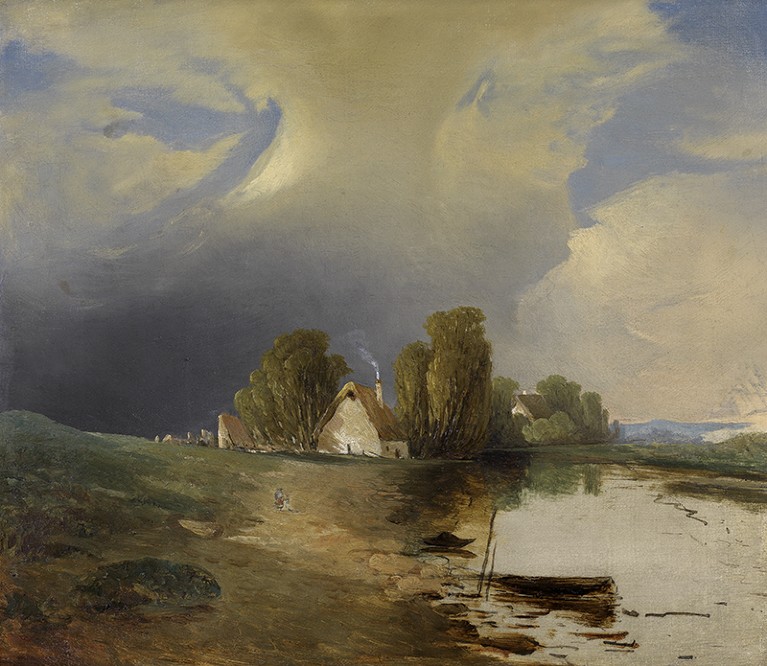
Adalbert Stifter’s depiction of the west Hungarian floodplains of the Danube, painted around 1841.Credit: Adalbert Stifter-Gesellschaft, Wien/Wien Mus.
Climate in Motion: Science, Empire, and the Problem of Scale Deborah R. Coen University of Chicago Press (2018)
A world power ruled by the eccentric Habsburg monarchy, the Austro-Hungarian Empire was a force to reckon with for the frenetic 50 years preceding 1918. In the comprehensive, deeply researched Climate in Motion, historian of science Deborah Coen explores a lesser-known side of this unwieldy empire: its role as a crucible of modern climatology. Imperial scientists were a starry league, from meteorologist Julius Hann, who explored the relationships between prevailing wind, rainfall and mean temperatures, to geographer Alexander Supan, who established the global classification system for climate zones.
Coen probes imperial society and culture to understand why the Austro-Hungarian scientific establishment and government devoted such vast resources to meteorology and climate sciences. She finds the driver in the political and social need to shore up an uneasy multinational alliance that incorporated what are now the Czech Republic and Slovakia, as well as parts of Poland, Italy and Romania, among other states. Historians are fond of saying that science is embedded in the context of a specific time and place. Coen demonstrates this unequivocally.
The sweeping narrative spans three-quarters of a century, from about 1850 to 1925. Coen has mined many archives to trace the intersecting careers of more than a dozen major figures — meteorologists, botanists, geographers, geologists, painters and writers. Anton Kerner, for instance, saw how the geographical distribution of plants could help to determine climate history. Here, too, are Adalbert Stifter, an immensely popular novelist, travel writer and landscape artist; Emanuel Purkinyĕ, Czech pioneer of microclimatology; and Wilhelm Schmidt and Felix Exner, among the first to conduct lab simulations of atmospheric circulation and its modification by topography.
Two themes knit together what is essentially a collection of interconnected, roughly chronological essays. The first is the empire’s struggle for unity in its diversity. The second is the problem of scale — an important element in climatology, where the range of interest runs from microclimates to global circulation.
The earlier Austrian Empire (1804–67) had suffered extensive territorial losses in a series of wars from the mid-eighteenth century to the Napoleonic era. Much of its energies were taken up with amalgamating the territory that remained. In 1867, a Habsburg compromise with the Hungarians created a larger, multi-ethnic collection of mainly Central European kingdoms under one imperial crown.
The new Austro-Hungarian Empire boasted more than ten major language groups, terrain ranging from alps to steppes, and transport and communication that remained rudimentary well into the nineteenth century. As Coen notes, successive governments under the long reign of Emperor Franz Josef I directed scholars to demonstrate that this all belonged under one flag. That was a potent issue in an age of national consolidation around linguistic units. The loose confederations of pre-unification Germany and Italy, for instance, could band together around a single national language and assertion of a common ethnicity. But this was not possible for the cultural melange that was Austro-Hungary.
Universities, institutes, museums, herbaria, observational networks, publishing houses and government bureaus settled on climatology, meteorology and the metaphor of atmospheric circulation as the scientific proof of the ‘naturalness’ of the empire. This group developed a science designed to show the dynamic interdependence of regions with wildly diverse topography, hydrography and vegetation. Just as the wind from Austria brought rain to the Hungarian plain, and alpine snows fed the lands of the Danube, so each region was shown to provide some climatic essential that an adjoining one lacked.
These ideas infused society. They were picked up by economists including Emanuel Herrmann, who took climatology as a model for spatial analysis of the imperial economy. That concept, in turn, was developed by liberals such as the social democrat Karl Renner, who argued that diversity actually created unity, and that trade grew through exchange of excess goods between regions. Implicitly and explicitly, climatic interdependencies served as the foundation for political and economic oneness in a jostling, polyglot empire.
There was a closely linked emphasis on climate at different scales, micro to macro. Local topography and hydrography produce climates in areas ranging from a few kilometres to vast continental spans, and much of the work of climatology involves integrating these varied zones. But the focus on scale was driven by that overarching social, economic and political need for unity.
First, researchers studied conditions on very small scales, to satisfy local economic needs and political aspirations. These were then integrated into a larger imperial framework, especially in the data and maps of the huge, multi-volume series Climatography of Austria, published between 1904 and 1919 — a vastly more detailed descendant of German polymath Alexander von Humboldt’s 1845 treatise Cosmos. Here, politics, rather than interfering, provided a rationale for doing a certain kind of science: descriptive, dynamic and focused on interdependence. That research was the seedbed of modern climatology. After the empire collapsed in 1918, catastrophically weakened by the First World War, the discipline was carried forward in Germany, Russia, Austria, Britain and North America.
There is a great deal more to this complex and reflective study. Coen examines how the empire promoted the popularization of science by leading experts while supporting research on the grand scale — an approach that stressed the patriotic, economic, cultural, even recreational utility of science. But the fact that climatology was born of a context of politics and policy, and was never far from them during its development, merits exactly this sort of examination as we wrestle with the ramifications of climate science today.

 China: A hydrological history
China: A hydrological history
 From Brookhaven to Bush
From Brookhaven to Bush
 In Retrospect: The Social Function of Science
In Retrospect: The Social Function of Science






